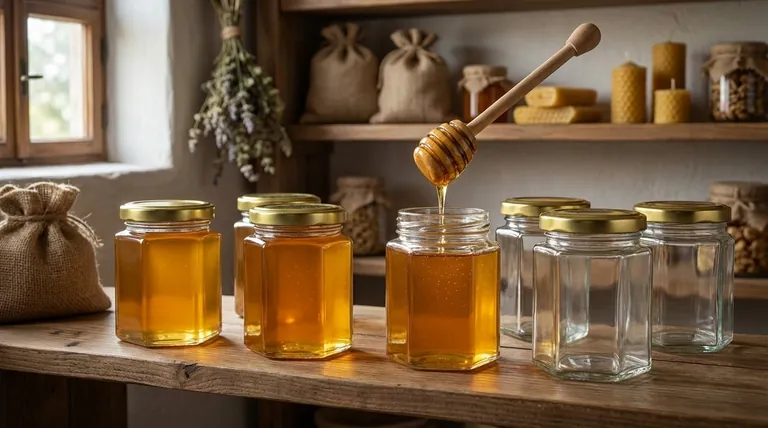For preserving the purity and flavor of honey, an airtight glass jar is unequivocally the best storage container. Glass is an inert, non-reactive material, ensuring that it will not interact with the honey's natural compounds or leach any unwanted chemicals. This guarantees the taste and quality of your honey remain exactly as intended.
The ideal storage for honey is not just about the container itself, but about creating a barrier against its primary enemies: reactive materials, air, moisture, and light. Your choice of container is the most critical first step in this defense.

Why the Container Material Matters
The container you choose directly impacts the honey's shelf life, flavor profile, and even its nutritional integrity. Honey is slightly acidic and can interact with certain materials over time, making the right choice essential for long-term storage.
The Gold Standard: Glass Jars
Glass is the superior choice because it is inert and non-porous. This means it will not react chemically with the honey.
It also provides an impermeable barrier against air and moisture. A tightly sealed glass jar prevents the honey from absorbing atmospheric moisture, which could lead to fermentation and spoilage.
The Common Alternative: Food-Safe Plastic
Many honey producers use food-safe plastic containers for their lightweight and non-breakable properties. This is an acceptable option for short-term use.
However, plastic carries a potential risk of leaching chemicals into the honey over time, a process that can be accelerated by exposure to heat or sunlight. For long-term storage, transferring honey from a plastic container to a glass one is a wise precaution.
The Material to Avoid: Metal Containers
You should never store honey in metal containers. The natural acids in honey can react with most metals, causing oxidation.
This reaction can contaminate the honey, alter its flavor significantly, and potentially make it unsafe to consume. While the metal lid on a standard glass jar is safe due to a protective inner lining, a fully metal can or tin is unsuitable.
Key Principles of Proper Honey Storage
Beyond the container itself, a few simple principles will ensure your honey remains in perfect condition indefinitely.
Keep It Airtight
Always ensure your container is sealed tightly. An airtight seal is crucial for keeping out moisture and other contaminants from the air.
Keep It in the Dark
Direct sunlight and prolonged exposure to light can degrade the sensitive enzymes and vitamins in raw honey. Storing your jar in a dark pantry or cupboard is the best practice.
Keep It at a Stable Temperature
Store honey at a cool, consistent room temperature. Extreme temperature fluctuations, both hot and cold, can negatively affect its texture and quality.
Common Mistakes to Avoid
Understanding common misconceptions can save your honey from unnecessary degradation.
The Refrigeration Myth
Do not refrigerate your honey. Cold temperatures will dramatically accelerate the natural process of crystallization, turning your smooth, liquid honey into a thick, granular state.
Panic Over Crystallization
Crystallization is not a sign of spoilage. It is a natural process that occurs when the glucose in honey separates from the water.
If your honey crystallizes, simply place the glass jar in a bowl of warm (not boiling) water and stir gently until the crystals dissolve.
Making the Right Choice for Your Honey
Your storage strategy should align with your goal for the honey.
- If your primary focus is long-term preservation and absolute flavor purity: Always choose an airtight glass jar and store it in a cool, dark pantry.
- If you purchased honey in a food-safe plastic container: It's perfectly fine for immediate use, but keep it away from heat sources and consider transferring it to glass for storage longer than a few months.
- If your goal is to restore crystallized honey: Use the gentle warming method in a proper glass or heat-safe container, never in a microwave, which can destroy its beneficial properties.
Ultimately, proper storage is about protecting the natural perfection of the honey you've purchased.
Summary Table:
| Container Type | Best For | Key Consideration |
|---|---|---|
| Glass Jar | Long-term storage, preserving purity | Inert, non-reactive, blocks air/moisture |
| Food-Safe Plastic | Short-term use, lightweight | Potential for chemical leaching over time |
| Metal Container | Avoid for storage | Reacts with honey's acids, causes contamination |
Protect the quality of your honey harvest with the right supplies from HONESTBEE. As a trusted wholesale supplier for commercial apiaries and beekeeping equipment distributors, we provide the durable, high-quality containers and equipment you need for proper storage and handling at scale. Ensure your product reaches customers in perfect condition. Contact our team today to discuss your wholesale needs and explore our product catalog.
Visual Guide

Related Products
- Hexagonal Glass Honey Jars with Metal Lug Caps Elegant Versatile Packaging
- Classic Drum Shaped Glass Honey Jar with Airtight Lid
- Stainless Steel Honey Storage Tank with Lid for Honey
- Inverted Squeezable Honey Jar with No Drip Flip Top Cap for Easy Pouring
- Premium Diamond-Faceted Glass Honey Dispenser
People Also Ask
- Why is a glass jar preferred for packaging honey? Ultimate Protection for Purity & Flavor
- How many jars of honey do you get from a hive? Unlock Sustainable Harvesting Secrets
- What are the advantages of using glass jars for honey packaging? Preserve Purity & Elevate Your Brand
- What is the term for honey can absorb moisture from the air? Understanding Hygroscopy
- What is the best way to jar honey? Preserve Quality with the Right Container



















